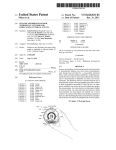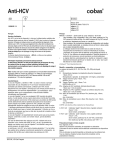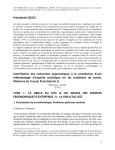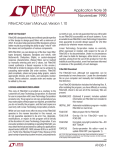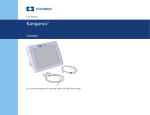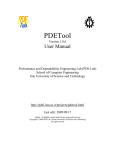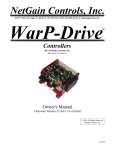Download HeatScore: Intelligent Thermostat System
Transcript
HeatScore: Intelligent Thermostat System A Report Submitted in Partial Fulfillment of the Requirements for SYDE 362 Al Amir-khalili, 20198393 Chris Best, 20200501 Kyle Morrison, 20203836 Vladimir Naoumov, 20198926 Faculty of Engineering Department of Systems Design Engineering Supervisor: Professor P. Fieguth April 6th, 2009. Course Instructor: Professor S. Birkett Abstract When it comes to heating in the home, there is a balance to be struck between user comfort and energy use. The HeatScore system seeks to reconcile these two metrics by creating and extrapolating a user-specific usage pattern, and using that pattern to determine when to heat the rooms, and more importantly, when not to heat the rooms. By only heating the rooms that the user actually uses, the system can reduce the energy use of the home, which in turn benefits the environment. The system is ingenious in the sense that it automatically develops this usage pattern based solely on selfish inputs at specific times that the users want the temperature to change. Furthermore, the user interface is designed to be intuitive in order to encourage inputs, and thus have a more accurate picture of the user’s needs. A custom algorithm is used to transform these inputs into a heating plan for the future, and by corollary to recognize when it can reduce the heat usage of the home. The final design of the system meets the various criteria of usability, functionality and performance defined by the group, and so the initial prototype is considered to be a success. Further areas of investigation include adding addition parameters (in other words, knowledge) to the algorithm, more functionality to the physical system (such as user feedback), and more universality in the form of cooling or humidity control. i Contents Abstract i Contents ii List of Tables iv List of Figures v 1 Background 1 1.1 Problem Area . . . . . . . . . . . . . . . . . . . . . . . . . . . . . . . 1 1.2 Approach . . . . . . . . . . . . . . . . . . . . . . . . . . . . . . . . . 1 1.3 Environmental Motivation . . . . . . . . . . . . . . . . . . . . . . . . 2 1.4 Prior Art and Novelty . . . . . . . . . . . . . . . . . . . . . . . . . . 3 2 Requirements 4 2.1 User Requirements . . . . . . . . . . . . . . . . . . . . . . . . . . . . 4 2.2 Functional Requirements . . . . . . . . . . . . . . . . . . . . . . . . . 5 2.3 Performance Requirements . . . . . . . . . . . . . . . . . . . . . . . . 5 3 Design Analysis 3.1 3.2 7 User Interface: Thermostat . . . . . . . . . . . . . . . . . . . . . . . . 7 Design Process . . . . . . . . . . . . . . . . . . . . . . . . . . . . . . 7 Innovative Aspects . . . . . . . . . . . . . . . . . . . . . . . . . . . . 11 Further Analysis . . . . . . . . . . . . . . . . . . . . . . . . . . . . . 11 Algorithm: The Relevance Scheduler . . . . . . . . . . . . . . . . . . 12 ii Design Process . . . . . . . . . . . . . . . . . . . . . . . . . . . . . . 12 Innovative Aspects . . . . . . . . . . . . . . . . . . . . . . . . . . . . 14 Further Analysis . . . . . . . . . . . . . . . . . . . . . . . . . . . . . 14 4 Testing and Evaluation 4.1 4.2 4.3 16 Functionality Testing . . . . . . . . . . . . . . . . . . . . . . . . . . . 16 Thermostat Units . . . . . . . . . . . . . . . . . . . . . . . . . . . . . 17 Central Unit . . . . . . . . . . . . . . . . . . . . . . . . . . . . . . . . 17 Prototype Testing . . . . . . . . . . . . . . . . . . . . . . . . . . . . . 18 User Interface . . . . . . . . . . . . . . . . . . . . . . . . . . . . . . . 18 Algorithm . . . . . . . . . . . . . . . . . . . . . . . . . . . . . . . . . 19 Environmental Assessment . . . . . . . . . . . . . . . . . . . . . . . . 20 Evaluation of System Benefits . . . . . . . . . . . . . . . . . . . . . . 20 Lifecycle Analysis . . . . . . . . . . . . . . . . . . . . . . . . . . . . . 23 5 Summary and Recommendations 25 5.1 Conclusion . . . . . . . . . . . . . . . . . . . . . . . . . . . . . . . . . 25 5.2 Recommendations for Further Designs . . . . . . . . . . . . . . . . . 25 References 27 iii List of Tables 2.1 User Requirements & Corresponding Performance Requirements . . . 6 2.2 Functional Requirements & Corresponding Performance Requirements 6 iv List of Figures 3.1 Layout of the System: Cross Section of the House . . . . . . . . . . . 9 3.2 Interface of the Thermostat . . . . . . . . . . . . . . . . . . . . . . . 10 3.3 Aggregated Temperature Schedule Given One Input . . . . . . . . . . 13 3.4 Aggregated Temperature Schedule Given Series of Inputs . . . . . . . 14 4.1 Sample Profile for Programmable Thermostat . . . . . . . . . . . . . 21 4.2 Sample Profile for HeatScore system . . . . . . . . . . . . . . . . . . 21 v 1 Background 1.1 Problem Area The problem of heating control in low to medium density residential housing is well studied. At the highest level, it involves a tradeoff between the preferences of the human occupants in terms of temperature, and the drive to minimize energy usage. With any type of heating the energy used to heat a home has both cost and environmental impact associated with it. Existing systems typically involve a thermostat control by which a user sets a preferred temperature or a temperature programme. The thermostat then controls a heating mechanism which aims to achieve that temperature. 1.2 Approach The system described in this report aims to improve upon existing home heating control systems in the comfort/energy trade-off. Only the heating control aspect of home heating will be considered; the mechanisms used to generate heat is outside the scope of this project except insofar as the control system needs to interface with them. By building intelligence into the control portion of existing heating techniques, the design aims to minimize energy usage while preserving or improving human comfort levels in a way that is not possible with existing solutions. 1 This is accomplished by designing a system that uses extremely simple, intuitive user input to infer a complex heating pattern. The assumption is made that a person always knows whether the temperature around them is warmer or cooler than they would prefer at a given instant in time. The system then takes this preference as an input and corrects the room temperature as quickly as possible, but it also records multiple inputs over time in order to develop a predicted heating preference pattern. This allows for a complex, near-optimal heat distribution plan to be created without the need for sophisticated planning on behalf of the user. 1.3 Environmental Motivation According to Natural Resources Canada, space heating accounts for 58.9% of residential sector energy use in Canada in 2006. This accounted for 39.6 of the greenhouse gas emissions due to energy use in this sector [1]. This is clearly an area where a small increase in efficiency could result in large positive environmental impact. One way to accomplish an increase in efficiency would be to improve the efficiency of heating mechanisms themselves by using more efficient furnaces, insulating homes, and similar techniques. To a large extent this has been done. According to natural Resources Canada, the proportion of medium and high efficiency heating systems compared to normal efficiency ones in single detached residences increased steadily between 1999 and 2006 [2]. This is progress, and it shows that people are willing to adopt technology that can present energy savings, which translates to both environmental and cost savings. However, thermal efficiency can only go so far. Even with extremely high thermal efficiency, there is room for further environmental savings by intelligently controlling the heating system, in particular turning it down or off when it is not needed. That is the benefit that will be pursued by this project. 2 1.4 Prior Art and Novelty The relevant patents found while searching for novelty fell into three general categories. The first were patents which relate to normal programmable thermostats, such as “Programmable time varying control system” [3] and “Programmable Thermostat” [4]. This technology is widely commercially available. In fact, 31% of Canadian houses have one, although one quarter of these do not use the programmability [5]. The second group of relevant patents involves improved thermostat control, with no significant modification to the usage pattern, such as “Wireless Programmable Thermostat Unit” [6]. The closest to the design from this group was “Thermostat with one button programming feature” [7], which upon closer inspection only allows a temporary modification to a fixed preset. Finally, there are systems which allow detailed monitoring of energy usage, such as US patent #6786421 [8]. The technology here would complement the design very well, but in no way cover the design. What is novel and ingenious about the approach presented in this report is the process by which a complex heating plan is developed automatically. Taking extremely simple user inputs, for which the user does not have to consider factors beyond their immediate needs, and translating a set of these inputs into an efficient, granular, predictive heating pattern is the key feature. No patent or commercial product discovered during the group’s research leveraged this approach. 3 2 Requirements To generate the system requirements, one must examine the problem to determine what the user would expect from a solution generated from the user requirements. These, in turn, are explored to see how the designed system should be addressing each system requirement on a conceptual level, generating a set of functional requirements. The final step is to see how the system performance can be evaluated, generating a set of performance requirements. These three sets of requirements are presented in the following sections. 2.1 User Requirements The requirements below are essential to ensure that the users are satisfied with how the proposed system addresses the problem of high cost (both monetary and environmental) of heating the home during the cold season. • Interface must be intuitive to the user. • The system must minimize the number of required user inputs once the learning cycle has been completed. • One has to be able to install the device into the house without any house modifications or significant modifications to the existing heating system inside the house. 4 • The system must improve heating efficiency without introducing user discomfort. • Must have a central override feature, that would turn the system off and disable heating for example when the users go on vacation. • The system must not create unsafe situations by overheating or over-cooling. 2.2 Functional Requirements The following set of functional requirements were developed to ensure that the system will be able to satisfy the user defined requirements. • The system must be able to measure the temperatures in each of the controlled zones of the house. • The thermostats must be able to transmit user inputs and temperature readings via wireless to the central controller on several frequencies to ensure it would not cause interference with the variety of other signals present in different houses. • The central unit must be able to store and process the input signals to generate a temperature pattern for each room. • The system has to be able to be retrofitted onto existing household heating systems. • The individual thermostats must fit into a typical lighting switch wall slot and be powered by the existing 110V line. 2.3 Performance Requirements Having analyzed the user and functional requirements, the following set of performance requirements was developed. Tables 2.1 and 2.2 demonstrates how end user requirements and system requirements translate into measurable performance requirements for the system, requirements that the final product must satisfy. 5 Table 2.1: User Requirements & Corresponding Performance Requirements Intuitive interface The interface must be understandable by 95% of users who spend at most 5 minutes looking at the user manual. Minimizing the num- The number of inputs required to maintain a developed ber of inputs user pattern is at most 1 per day Ease of installation Compatible with 80% of existing wall light switch slots. Compatible with 80% of existing heating systems. Both room and central units operate are powered by 110V. Improving efficiency The system must generate at least 5% energy savings versus alternative systems available to the users. Must have a central This requirement can be viewed directly override feature Table 2.2: Functional Requirements & Corresponding Performance Requirements Measuring tempera- Temperature is read in rooms to at least 0.5 degree pretures cision. If greater precision can be achieved at the same cost, the better solution should be implemented. Transmitting signals The system must be able to transmit the signal with at from thermostats to most 5% data loss within a 25 meter range. the central unit The system must be able to operate on 10 different frequencies. The operation of the The unit has enough memory to store 12 months of input central unit and temperature profiles for up to 10 zones. Must have an uptime of 99% with no data loss in case of power failure These requirements were used both during the design of the final product and for creating the testing sequences described in Chapter 4. 6 3 Design Analysis The design of the proposed system is divided into its two main components to facilitate the process of analysis. The two components are the thermostat and the trend extrapolation algorithm. 3.1 User Interface: Thermostat The thermostat is the main mode of interaction between the user and the system. As specified in the requirements, the interface needs to be simple, easy to use, and universal (see section 2.3). These requirements improve the marketability of this system by increasing the number of environments in which this system may be implemented. Design Process A method is desired to create a link between the user-friendliness and user-comfort requirements. Once this link has been made, another method can be designed to minimize the environmental impact without any compromises to the user-comfort and user-friendliness. Current thermostats set the room temperature as given by the user in degrees. Studies have shown that comfortable room temperatures for humans are not only functions of temperature. Comfortable room temperatures are in fact defined to be 7 a region as a function of both humidity and temperature [9]. Therefore, setting an absolute temperature is to be avoided. From this fact, the most reasonable way to determine the desired temperature is to measure it in relation to the current room temperature. The only similarity between the proposed thermostat and a conventional one is the inclusion of a temperature sensor inside the thermostat. Other than that, the entire interface is to be changed to allow for relative inputs. The initial idea behind the layout of the thermostat was to use a simple two button interface. As described in the approach section of the background, the two buttons behave as a means to capture the user’s desired temperature relative to the current room temperature. One button tells the system that the user desires the room to be warmer and the other tells the system that a lower temperature is desired. The method of parsing button presses is described in the algorithm section of this chapter (section 3.2). Now that a link has been made between comfort and user-friendliness, the design may be refined iteratively according to other requirements. Existing households with poor insulation are the main targets of this system. Therefore, the thermostat must be designed in such a way that allows for it be retrofitted into existing heating systems without extensive modification to the current heating system and the house. Thermostats are ideally installed in accessible locations and require a means to communicate with the heating system of the house. In situations where zone heating is used, it is desired for a thermostat to be installed in each of the divided heating zones. To address these concerns, the thermostat design allows for it to be just a drop-in replacement for a light switch. The reasoning is that light switches are normally located in accessible locations and each heat zone typically has an independent light switch. In order to avoid the need to install additional wiring (connecting the thermostat to the heating system) each thermostat is equipped with a wireless transmitter. The user inputs are captured and are sent to a controller, which in turn operates the existing heating system. The transmission of data from a thermostat via WiFi has already been done before [6]. Attempts were made to use a new and innovative means of communication. However, as is the case with new innovations, a lot of research is required to justify 8 Layout of the System Living Room Basement Furnace Controller Figure 3.1: Layout of the System: Cross Section of the House the method’s selection. An alternative method of communication is to use Power Line Communication (PLC). However, forcing data to be sent over power lines has not been subject to a lot of testing in this domain. For instance, PLC modems are especially big. Installing an entire modem inside a light switch may conflict with building codes. As a result, a decision is made in favour of wireless communication. Wireless transmitters are very small, require very little power, and are easily interfaced with using commercial micro-controllers. At this point, a prototype of the thermostat is created incorporating the features discussed so far. Its functionality is subjected to testing in tandem with a crude prototype of the Relevance Scheduler (section 3.2). It is observed that the design, in its current form, has failed to incorporate a feedback mechanism. Therefore, the next iteration of the design process is to implement a feature that enables the proposed thermostat to provide the user with feedback regarding the behaviour of the heating system. This feature is extremely important since it eliminates situations where inputs 9 are duplicated. Input duplication mostly occurs when users are unaware of how the system is responding to the previous input. This issue is magnified in the case of house heating. House heating is a special case because it takes quite some time for the system to heat the room to the desired temperature. Within the time it take for the system to heat up the room, other users who are unaware of the previous input may inadvertently increase the input temperature beyond what is actually desired. The proposed solution to this problem involves the inclusion of an array of feedback LEDs on the thermostat. Final Interface Design Recessed push buttons used to avoid false positives. The red button increases the target temperature. LED Array representing relative difference between current room temperature and target temperature. The blue push button decreases the target temperature. Figure 3.2: Interface of the Thermostat The LED array, in effect, displays the difference between the current room temperature and the desired temperature to which the system is heating the room. As the temperature in the room moves towards the desired, the number of LEDs turned on decreases. The LEDs only activate when a button is pressed, and remain on for a period of ten seconds before turning back off. This avoids unwanted illumination at night. 10 This concludes the main iterative design process. Some of the other final design decisions (including button shape and placement) are addressed in the Further Analysis section. Innovative Aspects There are three key features that make this design unique and innovative. These aspects, as summarized from the previous section, are as follows: • The system heats the house using relative desired temperatures • The thermostat captures inputs with an intuitive two button input • The system eliminates the need for house modifications by using wireless communication. Further Analysis Additional analysis was carried out to make a decision regarding what type of buttons would be ideal for the thermostat. After discussing the design with an expert [10], the following critical design criteria were developed: • The buttons must be recessed to avoid the accidental button presses while trying to toggle the light switch. • Buttons must be colored in contrast to aid users’ intuitive distinction of the functionality of the two. • The buttons must be shaped like triangles and positioned above and below the light switch to further juxtapose the two buttons for people who are visually impaired. These criteria are integral in insuring that the design is user-friendly. Therefore, they are taken into consideration in finalizing the design (See Figure 3.2). 11 3.2 Algorithm: The Relevance Scheduler The Relevance Scheduler behaves as an interface between the thermostat and the heating unit. It parses the binary inputs passed on to it from the two buttoned thermostat and generates a schedule based on pre-programmed heuristics. This schedule is then passed on to the heating unit, similar to inputs received from a generic programmable thermostat. Most of the design decisions made herein are based on intuitive heuristics. Future iterations of this design require explicit knowledge of the heating system being used in the application and the dimensions of each heat zone. Design Process The first step in designing such an algorithm is to determine how the inputs from the thermostat are going to be parsed. The binary input determines the direction in which the temperature is going to be stepped by the heating system. It was intuitively decided that the number of consecutive button presses must be parsed to represent, in a relative way, just how much the user wants the temperature to change. Each button press is mapped by the algorithm to represent a ‘Temperature Step’. The number of button presses are also capped at seven Temperature Steps to avoid overshoot. Intuition also determined that the size of each Temperature Step must depend on the current temperature. Consider the situation where the current room temperature happens to be 10◦ Celsius and a button is pressed to increase the temperature in the room. Intuitively, it is obvious that the Temperature Step is going to be rather large. However, the Temperature Step must be parsed to be relatively smaller when the room temperature is 25◦ Celsius and a button is pressed to increase the temperature. After the button presses have been parsed into a stepping direction, magnitude of steps (temperature), and number of steps, the next step is to design a feature which extrapolates a heating schedule by taking in these inputs, the current room temperature, and the date. The main challenge in designing such algorithm is to design it in such a way that it will be able to generate a schedule given sparse number of inputs. The first step in generating such a complicated feature is to break it 12 down and start by programming in heuristics which make intuitive sense. Typically, people’s schedules on weekdays differ from weekends. Therefore, if an input is received to increase the temperature to 23◦ at noon on Monday, it is very likely for this event to recur on Tuesday, whereas it is less likely for this behaviour to manifest on the weekends. Similarly, a perturbation on Monday this week is more likely to happen on the following Monday than other days of the current week. All of these basic features were implemented in the first iteration of the algorithm With regards to these intuitive notions, the algorithm takes an input and then aggregates the schedule by repeating this given input every 24 hours (Figure 3.3). However, the repetitions are scaled with respect to their similarity to the day in which that input was originally received; hence the name Relevance Scheduler. Figure 3.3: Aggregated Temperature Schedule Given One Input These basic heuristics were then compiled into a crude demonstrable prototype. The demonstration of the prototype to potential users revealed the opportunity for further heuristics to be programmed into the prototype. For example, inputs received at night (between 8pm and 6am) should be held for longer durations than those received throughout the day. The reasoning behind this is that if the nightly inputs were held for short period of time (e.g. 2 hours) the user might have to wake up in the middle of the night to add more inputs to the system. This would violate the user comfort requirement, and thus it was also added as a heuristic (Figure 3.4). These improvements formed the basis for the second iteration. As mentioned before, most of the parameters discussed in this section (i.e. hold 13 Figure 3.4: Aggregated Temperature Schedule Given Series of Inputs time and temperature step magnitude) are case specific. Testing is required to develop values depending on the method of heating, which is beyond the scope of this design (refer to Chapter 5). Innovative Aspects Unlike the design of the thermostat, which had many key innovative features, the implementation of a Relevance Scheduler is novel in and of itself. Although the thermostat design is new and innovative, its new features alone are not enough to fill the niche that this system is targeting. The proposed thermostat alone cannot deliver any energy savings. The novel features of the thermostat act as selling points by allowing the system, as a whole, to be easily implementable. It is the Relevance Scheduler’s unique ability to generate an optimized temperature profile, given minimal inputs, which makes the HeatScore system innovative. With this innovative feature, the HeatScore system stands out above the competition. Further Analysis Once the basic features have been derived, more functionality may be built into the algorithm to make it more robust by accounting for pathological cases where outliers occur among the inputs. Examples of such outliers (an event that only happens infrequently) are social events. During such events, the temperature only needs to be 14 adjusted at the time of the input and does not necessarily need to be replicated. The solution to this issue was to give each preset temperature a decaying lifespan. As mentioned in the iterative design process, the scheduled temperatures are programmed in relation to the time and day at which the input was given. The relations are now changed to be programmed in such a way that the signal will only be repeated for a maximum of three weeks. This will ensure that the outlier has been eliminated in three weeks. Once this feature was implemented, some interesting unexpected benefits were observed to exist within this feature, the most important of which was increased energy efficiency. This method also increases the efficiency by driving the temperatures to a preset minimum, which will further reduce heating, and yield an increase in energy savings. This effect is discussed in detail within the Environmental Analysis section of this report. 15 4 Testing and Evaluation The testing of the created system can be broken down into several individual components. First of all the functioning of the created system must be tested, which will be discussed in the first section. The second component is testing the algorithm that generates the temperature profiles and controls the heat production. This is a vital component of the created system, and thus a prototype was developed to help understand and further improve the algorithm. Further rationale for the prototype as well as the results of the prototype testing will be presented in section 2.2. Finally, even if the system is functioning the way it was designed, the environmental impact has to be assessed, which includes the environmental benefits the system offers as well as a basic lifecycle analysis of the created thermostat. 4.1 Functionality Testing Functionality testing will address most of the requirements that were discussed in the prior sections of the report. Since our system is made of individual components, each of these components separately. 16 Thermostat Units Requirement: Compatible with 80% of existing wall light switch slots. To ensure this requirement is met, the design has to fit into a typical slot advocated by the National Electrical Code in US and Canada, which is at least 3 x 2 x 2.75 inches [11]. As all residential light switches have to comply with the code, this would ensure that the requirement is met. Requirement: The wall unit must be powered by 110V. Since the system was designed to meet the requirement, it has been met. Requirement: Temperature is read in the rooms to at least 0.5 degree precision. The created system relies on using prefabricated components such as the temperature sensor. Thus it is believed that the supporting documentation for those components is reliable. The selected temperature sensor would then be chosen to meet the requirement at lowest possible cost. Central Unit Requirement: Compatible with 80% of existing heating systems. Statistics Canada suggests that roughly 80% of households use either hot air furnace or electric baseboards both of which are compatible with the system [1]. In the case of the hot air systems, flaps controlling the airflow to individual rooms. In the case of electric baseboards, they can also be controlled room by room using the signal from the central unit. Requirement: Powered by 110V and has a central on/off switch. Since the system was designed to meet the requirement, it has been met. Requirement: The system must be able to transmit the signal with at most 5% data loss within a 25 meter range on 10 different frequencies. Once again, the system relies on prefabricated components such as a wireless communicator in this case. Since it is more complex than a temperature sensor 17 and is crucial to the system performance, once the desired component is chosen it would be tested in a basement to attic communication scenario to ensure consistent transmission over a course of a day. Requirement: The unit has enough memory to store 12 months of input and temperature profiles for up to 10 zones with no data loss in case of power failure. The data storage component of the system would be chosen to satisfy these 2 settings, with no additional testing being required. 4.2 Prototype Testing A crucial component of the created system is the algorithm that controls temperature profile generation as well as the extremely simple user interface. In fact, these two things are the key differences setting the created system apart from others available on the market today. Due to their importance a prototype modeling a house with 3 rooms has been created to allow further tuning of the design of these 2 vital components. Since a real house was not available to implement the final solution, a testing environment has been created where the rooms are modeled. These rooms will be heated by the system-controlled furnace, and will cool naturally due to the outside temperature. The thermostat will also not include the LED user feedback that will be present in the final design. Although not very advanced, this prototype allowed some basic user and algorithm testing to be performed. User Interface The requirement to be addressed was the “The interface must be understandable by 95% of users which spend at most 5 minutes looking at the user manual”. This was tested during the symposium where the prototype was made available to the general public, ranging from students to professors to people who just happened to be there. Having only a brief explanation as to what the system did, they were then allowed 18 to interact with the prototype and see the results of their actions displayed back to them. The general feedback that was received was very positive. Most users found the system to be easy to understand and even when users have attempted to crash the system by generating random unnatural inputs, the prototype behaved as expected without generating any unpredicted outputs. The general feedback that was that our requirement of ease of use was well achieved. The only negative response that received was the fact that the prototype had no feedback to the user, something that the final design already addresses. Algorithm There are several requirements that the algorithm had to satisfy: first of all the number of inputs had to be at most one per day when the learning cycle is complete. Second, the algorithm had to produce behaviors that are compatible with what the user thinks would happen, in order to improve user friendliness. And finally, the generated temperature profiles should have better heating efficiency. Improving efficiency will be addressed in a later section, so initially the discussion will focus on how well the system satisfies the first requirement. This requirement depends on the end user preferences and comfort levels. For example, a person who is comfortable when the temperature is +/- 3 degrees of what they wanted will input less than a person who needs it to be +/- 1 degree. Thus, to test this requirement, a sample schedule is generated for a mock user that goes to work on weekdays and spends half his time at home during the weekends. Once the initial profile was set up, it is clear that the design has successfully maintained the preferences for the user, who use at most one input per day for another 2 weeks. This was done to a +/-2 degrees comfort level, meaning that input was only provided to the system if the user was assumed to be in the room and outside their comfort zone. Tests have shown that 1 input per day is more than enough to keep the temperature profile within the comfort level. Thus, on a prototype level, it is clear that the system meets the functional requirements. More testing may be necessary when the real system is 19 build and installed in a house to verify these findings in real life situations. The concept of the algorithm being user friendly was tested during the symposium when the prototype was available to the general public. While the users were interacting with the system, their feedback was collected to see if the system does what the users are trying to make it do. Once again, the response here was mostly positive; the system generated the temperature profiles in a way that was not unnatural to the users. Some of the more interested people asked for details about the operation of the algorithm that generates the temperature profiles and were supportive of the design solutions that were implemented. There were also several ideas for potential improvement that were suggested, such as modifying the algorithm to have different memory behavior for different rooms, or being able to give the system an initial profile at initialization different than just a minimum safe temperature at all times in every room. This feedback means that although the system is already performing to the specifications that were generated, there is room for future improvement. 4.3 Environmental Assessment Evaluation of System Benefits The last requirement that needs to be satisfied, thus justifying the designed system, would be the impact on the heating costs and consequentially on the environment. Although a numerical estimate of the impact would be impossible without any statistical testing, there are several observations that can be made. One can compare the temperature profiles that would be generated by a programmable thermostat to those generated by the designed system. In Figure 4.1 and Figure 4.2 below, a user’s preference in the living room is modeled. It can be seen from the two profiles that although both profiles generate comfortable temperatures in the mornings and evenings when the user requires the house to be heated, the area under the graph in Figure 4.2 is significantly smaller, indicating that less heating is required. 20 Figure 4.1: Sample Profile for Programmable Thermostat Figure 4.2: Sample Profile for HeatScore system 21 An additional advantage of the developed system is that the energy savings demonstrated above would be further increased due to the fact that the system generates individual heating profiles for each zone in the house, meaning only the used area of the house would be heated with the HeatScore system. Thus, while the profile generated by the programmable thermostat would remain the same for the bedroom as for the living room, the profile generated by our system would be different. Since the user does not require the bedroom to be heated at times other than when he/she is there, the profile would be able to adjust to heating the bedroom less than the rest of the house during the day, resulting in an overall savings for the user. Another advantage that the system provides the user with is being able to adjust to any changes in the users schedule without the users having to reprogram the whole system. If, for example, the user changes jobs and now comes back home one hour later than they did before, the input that set the house to be heated up earlier would no longer be relevant and would decay out, resulting in a new heating schedule that has the users new preferences accounted for. In comparison, the user of a programmable thermostat would have to remember to reprogram it, which may or may not happen. Since they are not experiencing any discomfort at any period of time, they would likely just be heating their house for an hour longer than they really need until they remember to reprogram it. Our system also offers additional benefit to users with children. Since it is very simple to use, the operation can be explained even to kids, who would most likely not be allowed to use the conventional thermostats. This would allow the concept of “heating where you need, when you need” to be in effect even if the only people at home are children. In comparison, a programmable thermostat would most likely be programmed to heat the house from the time children come home, as the adult user would not really know what part of the house needs heating and would not want to inconvenience their children. Finally, the most important advantage of using the system is the built in decay in the temperature profiles that happens over time. This means that outlier inputs do not affect the temperature profiles and that the profiles adjust to the users schedule. 22 There is also another impact that the decaying temperatures have: the user only provides input to the system when they are outside the comfort zone, and thus the temperatures are kept at the minimal comfortable level all the time. In comparison, for a programmable thermostat the user is forced to guess their comfortable temperature ahead of time and considering the fact that the comfortable temperature varies within several degrees, on average the preset would be higher than the resulting profile temperature generated by our system. One can see that the energy savings generated by the system depend on the users. This makes it impossible to pinpoint the exact value of savings generated by the designed system. Yet, overall the reasoning presented above makes it clear that the system provides many opportunities for the user to reduce their energy use. Since even a 1◦ C reduction in heating can provide up to 10% reduction in energy use [12], it can be clearly seen that the designed system would definitely meet the 5% energy reduction criterion set previously. Lifecycle Analysis The life cycle of the system would consist of four main stages : manufacturing, installation, maintenance and disposal. Manufacturing stage The system would be made of prefabricated components put together. For example, a thermostat unit would be made from a power converter, a temperature sensor, a wireless transmitter and an array of LEDs mounted onto a typical light switch. And the central processing unit would be an extremely simple computer with a storage device, a wireless transmitter and a power adaptor. All of these components are presently available on the market and thus it is not expected to see any significant environmental impact from their use or production. Installation stage One of the key criteria for the system was the ease of installation. All the user would need to do would be to replace their light switches with the thermostat units in the individual rooms and attach the central unit onto their existing heating system. This process is extremely simple and would not cause any significant amount of effort, and thus would not have any environmental impact. 23 Maintenance stage The device requires no maintenance during its operation. The only time any interference is needed is if one of the components breaks down. Since the device itself is very modular (the room units are independent) and made from a collection of simple and easily replaceable components, the repairs would not be a complicated job for any electrician. Disposal stage Since the device itself is a collection of various electronic parts, they could be easily reused or recycled using the existing electronics collection facilities available. There are several companies that specialize in this kind of services, such as Vancouver based Electronics Recycling Canada or Toronto based ADL Process Inc. Thus the disposal of the system can be done efficiently without producing any environmental damage. 24 5 Summary and Recommendations 5.1 Conclusion Heating makes up a large portion of residential energy use in Canada. Any reduction in the amount of energy required to heat homes presents a significant financial savings to users, and has a positive impact on the environment by reducing the amount of green house gasses emitted in absolute terms. Significant progress has been made in this area in the past decades, but there is room for further improvement by adding intelligence to the interface and control of residential heating systems. The design presented in this report provides an effective means to realize this improvement. By combining extremely simple user input, and an intelligent control algorithm which drives to minimize energy use given this input, this design offers significant energy savings. Because it does this while maintaining or improving user comfort levels, the value proposition to the user in terms of functionality and cost savings is excellent. Given the user appeal of this system, the design is successful in its end goal of being a viable means of helping the environment. 5.2 Recommendations for Further Designs In light of the success of the preliminary design, this report recommends that further research and design work be conducted to commercialize the system. In particular, 25 the following areas have not been fully covered in this report and should be addressed: • Integration with existing heating systems. This includes the mechanics of controlling a heating system, as well as further development of the algorithm to take heat dynamics into account, such as heat transfer between rooms. • Full parameter analysis. The system parameters chosen based on general research and intuition should be fully tested and verified. Furthermore, machine learning could be introduced to refine these parameters while online. • Increased scope of climate control. Active cooling and humidity control can be taken into account to provide a more complete climate solution. • Additional Input Mechanisms. Although the fundamental input mechanism is sound, further control can be given to the user at their option. Methods could include a computer interface, or an in-depth master control. These should never be required, but should supplement the simple primary input method. • Design for Manufacture. The design should be adapted for mass production. Key objectives are low manufacture cost, ease of installation, and minimal environmental impact. This report concludes that the design presented herein is a success with respect to the defined objectives. With the future improvements outlined above, the system has the potential to be a commercial success, to improve the quality of life of its users, and to help save the environment. 26 References [1] Office of Energy Efficiency, Natural Resources Canada, energy use and ghg emission by energy source.” “Secondary [Online] http: //oee.nrcan.gc.ca/corporate/statistics/neud/dpa/tablestrends2/ res_on_1_e_3.cfm?attr=0. (current Feb 2009). [2] Office of Energy Efficiency, Natural Resources Canada, “Heating system stock by building type and heating system type.” [Online] http: //oee.nrcan.gc.ca/corporate/statistics/neud/dpa/tablestrends2/res_ ca_27_e_3.cfm?attr=0. (current Feb 2009). [3] B. C. Hall, “Programmable time varying control system and method.” United States Patent 4,967,382, October 1990. [4] M. R. Levine, J. T. Russo, A. C. Cairo, and V. H. Rigotti, “Programmable thermostat.” United States Patent 4,606,401, August 1986. [5] Natural Resources Canada, Survey of Household Energy Use, 2003. [6] S. Dushane, T. Zimmerman, G. Bohm, and J. Staples, “Wireless programming or programmable thermostat mobile unit for multiple separate controller or programmable fixed units and programming transmission method.” United States Patent 6,196,467, March 2001. [7] S. L. Carey, “Thermostat with one button programming feature.” United States Patent 6,814,299, November 2004. 27 [8] H. Rosen, “Programmable thermostat including a feature for providing a running total for the cost of energy consumed during a given period for heating and/or cooling a conditioned space.” United States Patent 6786421, September 2004. [9] Information Please, All the knowledge you need., “Winter indoor comfort and relative humidity.” [Online] http://www.infoplease.com/ipa/A0001412.html. (current March 2009). [10] V. Goyal, “Expert analysis: User-centric design.” Personal INTERVIEW. (March 11, 2009). [11] J. Markell, “Residential Wiring to the 2005 NEC,” p. 6, 2005. [12] B. Stats, “The Heat is On: Energy Use and Household Heating in B.C.,” 2008. 28


































